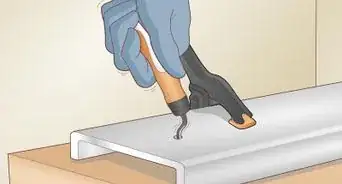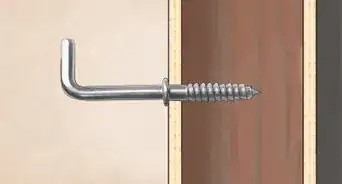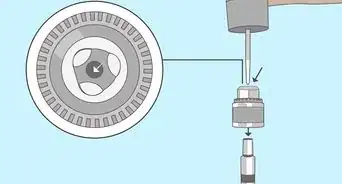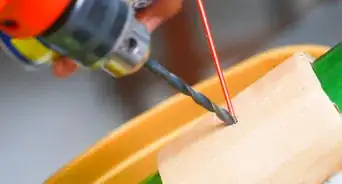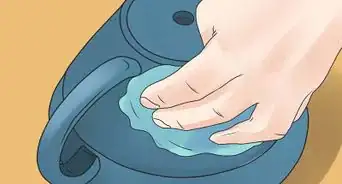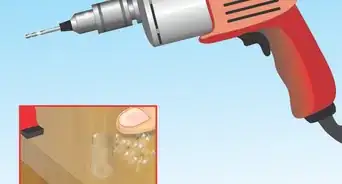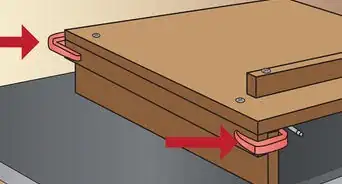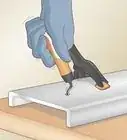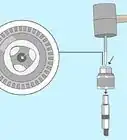wikiHow is a “wiki,” similar to Wikipedia, which means that many of our articles are co-written by multiple authors. To create this article, 11 people, some anonymous, worked to edit and improve it over time.
This article has been viewed 476,573 times.
Learn more...
Lock-drilling is a last-resort approach to gaining entry to locks that cannot be opened by other means. Drilling a lock will destroy the locking plug, but should leave the mechanism in working order. If you must do it, you can learn to examine the lock and approach the task properly, with the right equipment for the job.
Steps
Getting Started
-
1Examine the lock. Some tubular locks have a center pin made of hardened steel, while others have a ball bearing in the middle pin to prevent drilling. In either case, drilling will prove ineffective and alternate lock-picking methods must be used. If you are unsure if the lock is made with a hardened center pin, consult a local hardware store or locksmith and give them as much information as you have on the lock.[1]
- It's also important to double-check and make sure that you're working with a basic tumbler lock that you'll be able to knock out, and that there aren't other locking mechanisms on the door that'll keep you out. Disable any alarms before attempting to drill a lock.
-
2Get the proper equipment. Since you're using a pretty primitive method to get the lock open, you won't need many sensitive tools to get the job done properly. If you need to drill through a lock, you'll need:
- A variable-speed power drill. You want a well-maintained and powerful power drill that you'll be able to use to break the lock mechanism. It would be very difficult to do this by hand.
- Several sizes of drill bits. There's no one drill-bit that'll be better than others, because you want to match it to the size of the lock. Have a few on hand to experiment with.
Advertisement -
3Attach a 1/8-inch (3mm) drill bit to your drill. For the most part, if it's going to work, you'll be able to get it started with a bit that's about an eighth of an inch wide. If you don't have a bit that size, go with something in the neighborhood. You want it relatively small, going through the mechanism, rather than drilling it out completely.
-
4Hammer a center punch at a point directly above the keyhole. This will create a guidance point for drilling. The point should be just below the shear line, the dividing line between the inner and outer cylinder of the lock, which will keep the drill bit on the center plug. This should be high enough to effectively drill through the pin tumblers.
- If you have difficulty finding the right place to sink your guidance hole, you can purchase a lock-drilling template. Templates for a variety of locks are available at locksmith shops and hardware stores.
Drilling the Lock
-
1Drill a hole through the lock cylinder through the guidance point. This destroys the pins inside the lock cylinder, allowing you to force the lock open. Most locks have about five tumbler pins to drill through, although some have six or more.[2]
- You should feel more resistance as the drill bit encounters each pin, then a decrease in resistance as the bit cuts through the pin.
- If the drill binds while drilling, you may need to put the drill in reverse and pull it out of the lock to draw out excess metal filings created by drilling through metal. Lock-drilling templates for a variety of locks are offered for sale by locksmith businesses and hardware stores.
-
2Go slowly. Feel the drill work and try not to work too quickly or press too hard, as this may jam or break the drill bit. If you're having difficulty getting the bit to drill through the pins, you can stop at any time and lubricate the drill head with a little water or a synthetic oil lubricant to make the drilling easier.[3]
- Keep the drill level while drilling. If you drill at an angle, you can accidentally drill through unnecessary metal and damage more of the lock.
-
3Switch to a slightly larger bit. After going through with your smaller bit, take it up a notch. Attach a 1/4-inch (6.5mm) or larger drill bit to your drill, and go through the lock again with the larger bit to break up the pins more and open the lock.[4]
-
4Insert the blade of a flat-headed screwdriver into the lock head. Turn the locking mechanism in the same direction as you would with a key. If you drilled correctly, the locking mechanism will turn, and you will gain entry to the previously locked door. If the lock still will not turn, you may need to destroy the entire lock cylinder, as described below.[5]
-
5Improvise if necessary. Some locks may be more complicated, meaning that you’ll have to drill through the entire lock assembly to open the locked area. Switch to either a larger 3/4 inch (19 mm) drill bit or a specially made cylindrical tubular lock bit. Tubular lock bits are generally 3.75 inches (9.53 cm) and similar to hole saws used to drill larger holes for installing locks in doors.
- Drill through the entire mechanism. This will destroy the entire lock. You will then be able to access the previously locked area.
Community Q&A
-
QuestionWill this work on a tall file cabinet too?
 Glenn LetteerCommunity AnswerFile cabinets generally have two types of locks, pin tumber and waffer. It is not possible to drill a waffer lock as they have no shear line. The keyways on file cabinet pin tumbler locks are very small. As such, if you are going to attempt drilling one, you need a much smaller bit. If you choose the wrong bit size, you may split the cylinder plug. If this happens, you have a problem on your hands.
Glenn LetteerCommunity AnswerFile cabinets generally have two types of locks, pin tumber and waffer. It is not possible to drill a waffer lock as they have no shear line. The keyways on file cabinet pin tumbler locks are very small. As such, if you are going to attempt drilling one, you need a much smaller bit. If you choose the wrong bit size, you may split the cylinder plug. If this happens, you have a problem on your hands. -
QuestionCan I drill a front door tumbler that has locked me in?
 Upnorth HereTop AnswererYes, you can generally drill any lock cylinder that is not made of metal harder than your drill bit. If your front door is a required "means of egress" for fire safety, it should not require any keys to exit. In many places it would be a violation of fire code and building code.
Upnorth HereTop AnswererYes, you can generally drill any lock cylinder that is not made of metal harder than your drill bit. If your front door is a required "means of egress" for fire safety, it should not require any keys to exit. In many places it would be a violation of fire code and building code.
Warnings
- The techniques described herein are intended to be used only for gaining entry into your own personal property. Drilling a lock to gain entry into someone else's private property falls under the crime of breaking and entering and is subject to serious legal consequences.⧼thumbs_response⧽
Things You'll Need
- Drill
- Drill bits
- Flat-bladed screwdriver
- Work gloves
- Safety goggles
- Hammer
- Center punch
References
- ↑ https://unitedlocksmith.net/blog/6-things-you-must-do-before-drilling-a-lock
- ↑ https://homesteady.com/how-6059008-drill-open-lock.html
- ↑ https://www.fireengineering.com/articles/print/volume-157/issue-9/departments/training-notebook/drilling-lock-cylinders.html
- ↑ https://homesteady.com/how-6059008-drill-open-lock.html
- ↑ https://www.fireengineering.com/articles/print/volume-157/issue-9/departments/training-notebook/drilling-lock-cylinders.html
About This Article
Before you attempt to drill a lock, keep in mind that you won't be able to drill locks that have a center pin made of steel or a ball bearing in the middle pin. To get started, hammer a center punch into a point just above the keyhole and take it out. Then, using an 1/8-inch drill bit, slowly drill through the point you made with the center punch. Next, replace the drill bit with a 1/4-inch bit, and repeat the process. Finally, insert a flat-head screwdriver into the lock and turn it to unlock the door. To learn how to tell what kind of lock you're working with, read on!
